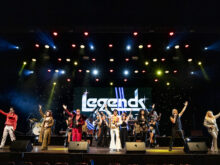FOR IMMEDIATE RELEASEMedia Contacts:Jill Heppner, Legends in Concert Marketing(417) 339-3003 ext. 3010 | Jill.heppner@legendsinconcert.com Anna Hellgeth, PepsiCoAnna.hellgeth@pepsico.com LEGENDS IN CONCERT THEATER IN BRANSON RENAMED TO PEPSI LEGENDS THEATER Branson, MO – February 8, 2024 – Legends in Concert, known as the world’s greatest live tribute show, has entered a new sponsorship with PepsiCo, resulting in […]
Capturing the Essence: The Art of Being a Musical Tribute Artist
In the world of music and performance, there exists a unique and captivating art form: the Musical Tribute Artist (MTA). These performers devote themselves to recreating the spirit, sound, and stage presence of some of the most iconic musicians in history. However, being an MTA involves far more than mere impersonation. It’s about channeling the essence of the artist and delivering an experience that resonates deeply with audiences across generations.
The Art of Musical Tribute: More Than Imitation
At first glance, one might assume a tribute artist simply mimics the look and mannerisms of a famous figure. Yet the craft runs much deeper. A true MTA immerses themselves in the artist’s life, music, and story. They study interviews, live performances, and personal anecdotes — not just to copy, but to understand what made that artist unforgettable.
By tapping into the emotional and artistic core of their subject, MTAs aim to recreate not only the performance but the presence of the icon they portray.
Nostalgia as a Powerful Connector
Perhaps one of the most profound aspects of being a tribute artist is the ability to evoke nostalgia. Legendary songs often carry deep emotional value, reminding people of pivotal moments in their lives. When an MTA performs, they don’t just sing familiar tunes — they transport the audience through time. They create a shared space where memories resurface, emotions rekindle, and the past comes alive once more.
A Tribute Beyond the Music
While music is the heartbeat of any tribute, a successful MTA knows that visuals matter too. From costumes and makeup to mannerisms and stage gestures, every detail contributes to the illusion. Wearing an artist’s iconic outfit or capturing their signature hairstyle enhances the authenticity of the performance, making it a fully immersive experience for the audience.
Channeling Energy in Live Performance
There is no greater test — or thrill — for a tribute artist than performing live. The spotlight demands transformation. The MTA must embody the energy, charisma, and magic of the artist in front of a live audience. Precision in vocals is crucial, but equally important is commanding the stage with confidence and emotion.
Achieving this level of artistry takes more than talent. It requires countless hours of practice, an intuitive sense of audience engagement, and a deep emotional connection to the music.
Honoring the Legacy
To portray a musical legend is also to protect their legacy. Tribute artists take this responsibility seriously. They recognize they are celebrating—not replacing—icons who have shaped music history. By preserving and sharing these artists’ work with new generations, MTAs ensure the flame of their influence never fades.
Bridging Generations Through Song
Tribute artists also serve as bridges between eras. Their performances introduce classic music to younger audiences who might not have experienced it firsthand. In doing so, they unite people across generations, fostering appreciation and connection through the timeless power of music.
Conclusion: Living Tributes to the Power of Music
In a world where music continues to transcend time and culture, musical tribute artists keep the spirit of legends alive. Their work goes far beyond impersonation — it’s about emotion, connection, and reverence. MTAs invite us to remember, to feel, and to celebrate. So the next time you see a tribute artist perform, take a moment to recognize the dedication behind their craft. You’re not just watching a show — you’re witnessing a living tribute to music’s enduring legacy.


